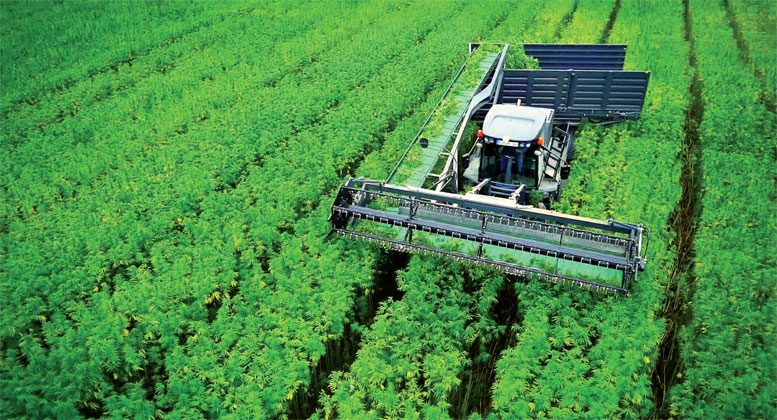
American hemp farmers will need industrial size machines like the Multi Combine HC 3400 from Hanf Farm, Berlin.
While European hemp companies have found a fertile market in the United States for years, the growth of farming and processing in the USA is bringing further opportunities to Euro firms which have developed world-leading technology to turn out hemp-based products.
From specialized farming equipment to high-tech extraction facilities, Hemp USA needs to ramp up production for a wide range of products – even as the industry continues to be under constraining government-controlled programs.
From specialized farming equipment to high-tech extraction facilities, Hemp USA needs to ramp up production for a wide range of products – even as the industry continues to be under constraining government-controlled programs.
“The greatest bottleneck we’re seeing along the value chain is among U.S. processors on the dual purpose side of the industry,” said Thomas Dermody, Executive Director of the Colorado-based Industrial Hemp Research Foundation (IHRF).
“From on-site to secondary processing, we need a vast ramp-up in available technology, or (U.S.) companies need to work on licensing agreements that let them bring over European tech to handle the vast amount of raw material we could see by harvest season,” Dermody told HempToday, noting some estimates that Colorado alone could produce hemp from 35,000-46,000 acres (86,000-114,000 ha.). “Where we are going to process all that material remains to be seen,” Dermody said.
Demand for knowhow
And while the USA boasts as many as 25 state-run hemp research programs under way or soon coming on line, U.S. industry sources say the lessons learned from Europe’s many years of trial and error can also prove valuable as the world’s biggest market for hemp goods continues the shift from an export-driven supply model to a home-grown value chain – an opening for European hemp consultancies.
For European hemp firms, the potentially behemoth American hemp industry carries a double-edged sword, of course. Transferring technology and knowhow to the USA is sure to speed up U.S. supply chain development, thereby decreasing demand from elsewhere in the world. Still, that’s seen as a longer term proposition that leaves plenty of room for short-term export growth among Euro hemp firms, said American hemp adviser Richard Rose.
“While U.S. states dither by requiring research only by universities, Europe is growing almost as much hemp as Canada, and allowing full commercialization with THC as high as 1%,” Rose said. “Many (U.S.) states as well as Canada ban hemp CBD, losing 98% of potential value,” he added.
“So Europe is setting the stage to be a supplier to the world, including China. Want cheap production? Go to Ukraine. Want massive fields? Go to Poland. Want hassle-free extraction? Go to the Czech Republic. Want the best hempseed oil in the world? Go to Italy,” Rose said.
Central Europe expands
Rose’s analysis signals another trend in Europe: The rise of hemp in Central European countries, several of which have vast farmland and are quickly waking up to hemp’s potential in farming, processing and marketing.
Those states are led by tiny Estonia, which this year jumped into second place behind France in total hemp hectarage, according to EIHA’s annual field report. But Central Europe’s potential is best spelled out in bigger countries such as Poland, Romania and Ukraine, all of which have vast farmland and rich histories in hemp farming, processing and research; they also have examples to follow in Slovakia and the Czech Republic, more developed markets that make up a sort of advance guard for Central European hemp.
Foods going mainstream
In wider Europe, branded hemp food and food raw materials suppliers continue to enjoy an expanding market across the continent, led by Germany, where hemp foods have moved into the mainstream. But while CBD markets have appeared to hold up over the past year, the sector has not been without its problems.
For starters, the push for a medical designation on CBD in the UK roiled industry players late last year. Around that same time, red flags also went up over an amendment to the federal Regulation on Prescription Medicines in Germany that essentially designated all CBD-laced products as prescription-only without any consideration for dosages or administration methods. The amendment was based on an earlier recommendation by an expert group from Germany’s Federal Institute for Drugs and Medical Devices
Those developments quickly drew a proposal from the EIHA calling for a three-tier regulatory framework for CBD products to address the current “tenuous patchwork” of rules covering CBD and hemp extracts in the European Union. Changes would address unclear rules for hemp foods and supplements, guidelines affecting such things as dosage levels, rules for over-the-counter products such as supplements, and CBD levels allowable in food products.
Isolates drive CBD
The developments in Europe were meanwhile compounded by a clampdown last year in the USA – an anchor CBD export market – over what government regulators called dubious health claims being made by some CBD vendors.
Despite those hiccups, and the potential market interruptions they imply, CBD shortages could – ironically – emerge throughout the summer, driven by the fast growth in demand for isolates, which require more material than simple CBD oils or extracts, said Richard Rose. “There could be a glut come post-harvest in October, but until then shortages are possible,” Rose said. The development of isolates alone shows a CBD sector that is gaining in sophistication and expanding into more and more sub-sectors, which Euro CBD producers are quickly populating with new products.
No comments:
Post a Comment